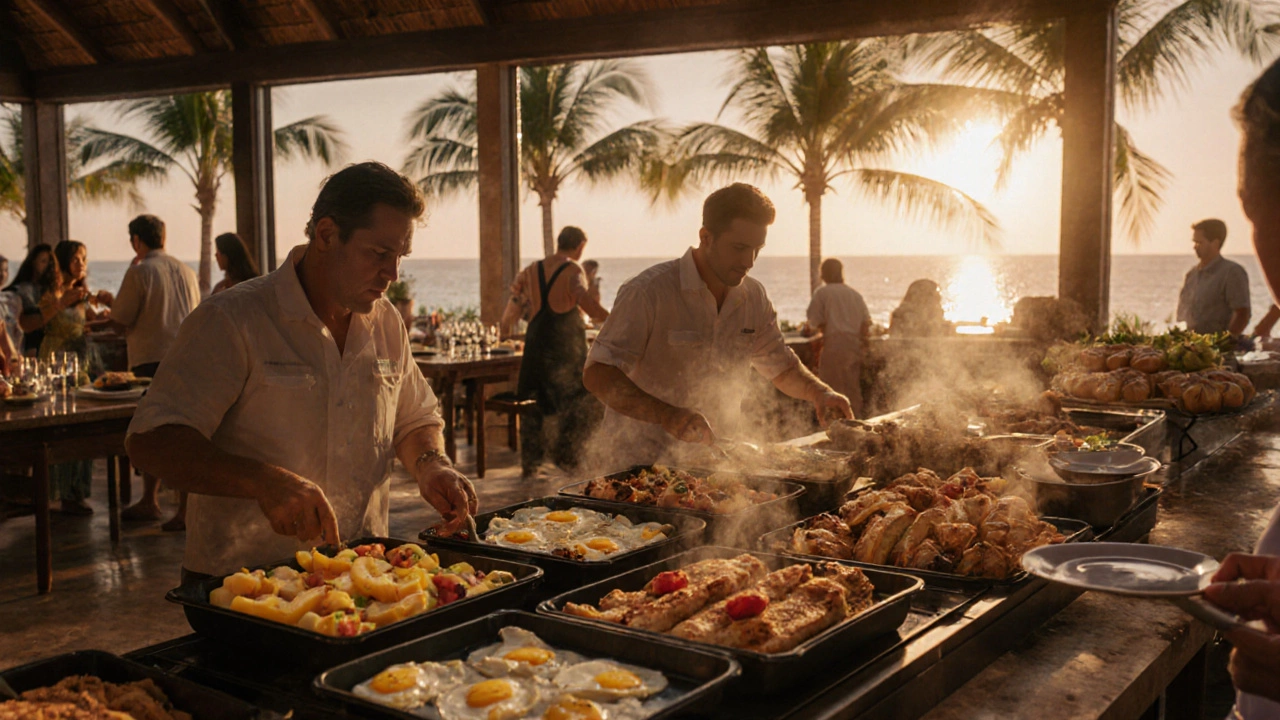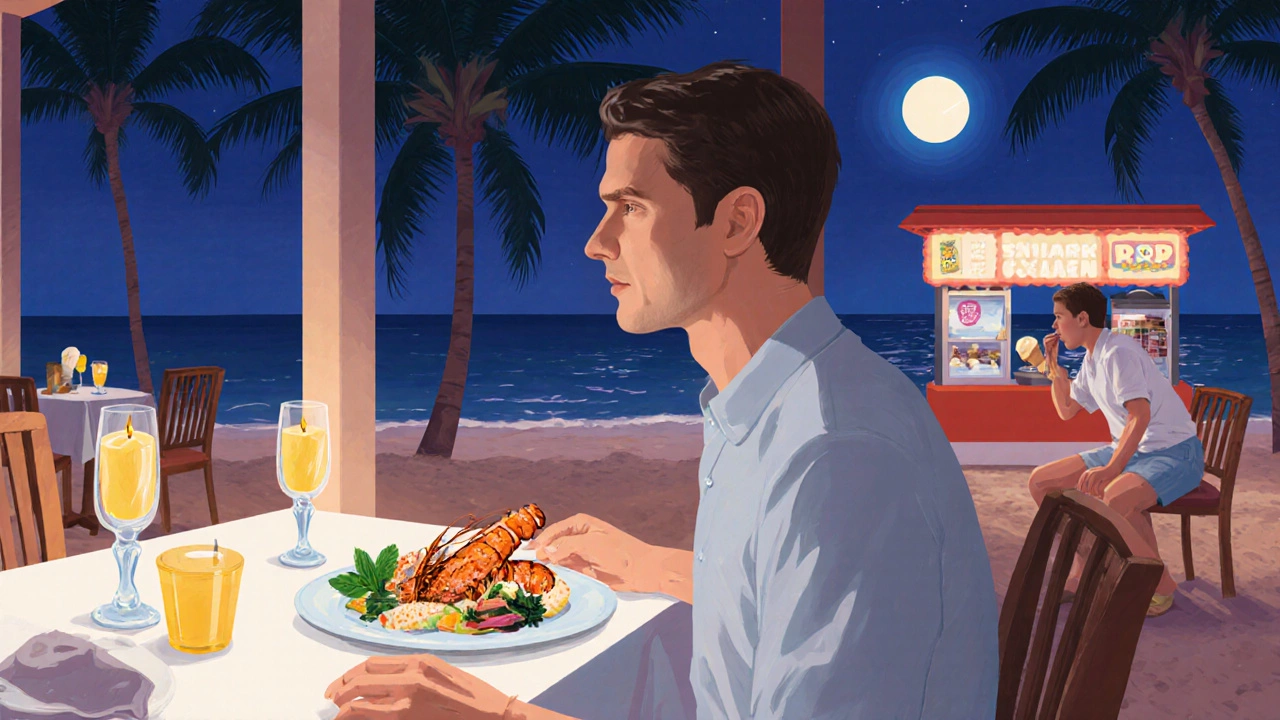Can You Eat as Much as You Want at All-Inclusive Resorts? The Real Rules
 Nov, 11 2025
Nov, 11 2025
All-Inclusive Resort Dining Calculator
Calculate your optimal dining experience based on resort policies and your preferences. This tool shows realistic limits based on the article's strategies.
Pro Tip
Resorts typically include 3-4 meals and 6-8 drinks per day. This calculator shows realistic limits based on standard policies.
Most people picture all-inclusive resorts as a free-for-all buffet with endless pasta, ice cream, and cocktails-like a food carnival with a beach view. But here’s the truth: you can eat as much as you want… but only if you know where to look and when to go. It’s not magic. It’s strategy.
What ‘All-Inclusive’ Actually Means
When you book an all-inclusive resort, you’re paying for access-not unlimited everything. The package covers meals, drinks, snacks, and sometimes activities. But that doesn’t mean you can stuff yourself at every station, every hour, without consequence.
Resorts have costs too. Food waste, labor, and ingredient prices aren’t infinite. Most places build their pricing around an average guest consuming 3-4 meals and 6-8 drinks per day. If you show up and eat 10 meals, you’re not breaking any law-but you’re definitely testing the system.
Real talk: resorts don’t want you to overeat. They want you to enjoy, relax, and come back next year. That’s why they design the experience to feel abundant, not chaotic.
Where the Buffet Rules (and Where It Doesn’t)
The buffet is your best friend. Most all-inclusive resorts have at least one large buffet open for breakfast, lunch, and dinner. This is where you can load up on eggs, pancakes, fruit, pizza, grilled fish, rice, beans, and dessert. No one’s counting plates. No one’s checking your waistline.
But here’s the catch: the buffet isn’t always open. Many resorts switch to à la carte dining for dinner. That means you pick one appetizer, one main, one dessert. No seconds. No extra bread. No thirds on the tiramisu. This isn’t a trick-it’s standard. Resorts use this to control costs and offer a more refined experience.
Some resorts let you do the buffet for breakfast and lunch, then switch to reservations-only restaurants at night. Others give you one or two free à la carte meals per week, with extra meals costing $20-$50. Always check your resort’s dining policy before you go.
Drinks Are the Wild Card
Drinks are where things get fuzzy. Most resorts include soft drinks, local beer, house wine, and basic cocktails. Premium brands? That’s extra. Think Grey Goose, Macallan, or imported champagne. You’ll pay for those.
Some resorts have ‘premium all-inclusive’ packages that include top-shelf liquor. But even then, there’s usually a limit. One drink every 30 minutes? Two per meal? Some places quietly track how many drinks you order in a day. Not to punish you-to prevent abuse. A guest ordering 12 mojitos by noon isn’t the norm they’re designing for.
And don’t assume all drinks are created equal. Bottled water? Often included. Sparkling water? Sometimes. Coffee? Usually yes. Specialty lattes? Maybe not. Always ask.

Snacks, Ice Cream, and Midnight Binges
Here’s the good news: snacks are usually fair game. Most resorts have snack bars open from 10 a.m. to 10 p.m. with chips, fruit, cookies, sandwiches, and ice cream. You can hit the ice cream machine three times a day if you want. No one will stop you.
Some resorts even have 24-hour snack stations near the pools or in the lobby. Think popcorn, granola bars, and fruit cups. These are designed for lazy afternoons and midnight cravings. Take advantage.
But again-there’s a line. If you show up at 2 a.m. with a plastic tub and start scooping ice cream for a group of six, you might get a polite but firm request to tone it down. Staff aren’t rude-they’re just protecting the system.
What Happens If You Go Overboard?
Let’s say you eat five dinners, snack all day, and drink six cocktails before noon. What happens?
Nothing. Legally, nothing. Resorts won’t kick you out. They won’t charge you on the spot. But you might notice a few things:
- Staff start recognizing you-and not in a good way. You’ll get the ‘we’ve seen this before’ look.
- Reservations at the fancier restaurants get harder to book. They prioritize guests who seem to be pacing themselves.
- Some resorts quietly flag heavy eaters for future marketing. You might get a post-vacation email: ‘We noticed you loved our lobster. Want to try it again next year?’
It’s not about punishment. It’s about balance. Resorts thrive on repeat guests. If you leave feeling bloated, guilty, or sick, you’re not coming back. And that’s the last thing they want.
Pro Tips to Eat Smart, Not Just More
You don’t have to be a food monk to enjoy all-inclusive dining. Here’s how to eat well without overdoing it:
- Start with the buffet at breakfast. Load up on protein and fiber. You’ll stay full longer.
- Use your à la carte meals wisely. Save them for seafood nights or steak dinners you can’t get at home.
- Drink water between alcoholic drinks. It helps you feel full faster and reduces hangovers.
- Hit the snack bar after lunch, not right before dinner. It keeps you from overeating at the main meal.
- Try local specialties. A resort in Mexico should mean tacos and ceviche. One in Jamaica? Jerk chicken and mango pudding. Eat the culture, not just the calories.

Resorts That Actually Let You Eat Everything
Some resorts are built for food lovers. These are the ones where you can truly eat as much as you want:
- Beaches Resorts (Jamaica, Turks & Caicos): Multiple buffets, 24-hour snack bars, unlimited à la carte meals for most guests.
- Secrets Resorts (Mexico, Dominican Republic): Premium all-inclusive. Includes top-shelf drinks and unlimited dining at 8+ restaurants.
- Club Med (France, Caribbean): Buffets are open all day. Snacks, desserts, and drinks are always available. No reservations needed.
- RIU Resorts (Spain, Mexico): Large buffets, late-night snack options, and multiple themed restaurants.
These places are designed for people who want to eat, drink, and repeat. If you’re planning a food-first vacation, pick one of these.
What to Avoid
Don’t fall for the trap of thinking ‘all-inclusive’ means ‘no rules.’ You’ll get disappointed. Avoid these mistakes:
- Expecting gourmet meals at every meal. Buffet food is good, not fine dining.
- Assuming you can eat at the steakhouse every night. Most resorts limit it to one or two times per stay.
- Drinking all day without water. You’ll feel awful and miss out on the beach.
- Trying to eat like you’re in a competition. You’re on vacation, not in a food challenge.
Resorts aren’t designed to be food vacuums. They’re designed to be relaxing. The best meals aren’t the ones you eat the most of-they’re the ones you remember.
Final Verdict
Yes, you can eat as much as you want at all-inclusive resorts. But you shouldn’t. Not because you’ll get in trouble-but because you’ll miss the point.
Travel is about experience, not consumption. Savor the fresh mango. Enjoy the sunset with a cocktail. Try the local fish stew. Eat until you’re satisfied, not stuffed.
The best vacation isn’t the one where you ate the most. It’s the one where you felt the most-full of flavor, not just food.
Can you really eat unlimited food at all-inclusive resorts?
You can eat as much as you want at buffets and snack stations, but most resorts limit à la carte dining to one or two meals per stay. Premium restaurants often require reservations and may charge extra after your included meals. It’s not about quantity-it’s about balance.
Are drinks really unlimited at all-inclusive resorts?
Basic drinks like soda, local beer, house wine, and standard cocktails are included. Premium spirits, imported wines, and specialty coffee drinks usually cost extra. Some resorts also limit how many drinks you can order per hour to prevent abuse.
Do all-inclusive resorts charge you if you eat too much?
No, they won’t charge you extra for eating too much. But if you’re clearly overusing the system-like ordering 10 desserts or hoarding food-you might get a polite warning. Resorts care more about your experience than policing your plate.
Is it worth upgrading to premium all-inclusive?
If you love gourmet food, top-shelf drinks, and dining at multiple restaurants, yes. Premium packages usually include unlimited à la carte meals, premium liquor, and specialty dining. But if you’re happy with buffets and local beer, the standard package is fine.
What’s the best time to eat at all-inclusive resorts?
Go to the buffet right after it opens-usually 7-8 a.m. for breakfast and 12-1 p.m. for lunch. That’s when the food is freshest and the lines are shortest. For dinner, book your à la carte meal early. Popular restaurants fill up fast.
